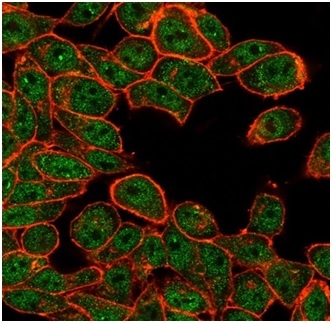Learn about our comprehensive antibody validation methods to ensure monospecificity. Antibody Validation>>

Flow Cytometric Analysis of PFA-fixed HeLacells. ATF2 Mouse Monoclonal Antibody (PCRP-ATF2-1B4) followed bygoat anti-mouse IgG-CF488 (blue); unstained cells (red).

Immunofluorescence Analysis of HeLacells stained using ATF2 Mouse Monoclonal Antibody (PCRP-ATF2-1B4) followed by goat anti-mouse IgG-CF488 (green). CF640A phalloidin (red).

Immunofluorescence Analysis of HeLacells stained using ATF2 Mouse Monoclonal Antibody (PCRP-ATF2-1B4) followed by goat anti-mouse IgG-CF488 (green). CF640A phalloidin (red).
This gene encodes a transcription factor that is a member of the leucine zipper family of DNA binding proteins. The encoded protein has been identified as a moonlighting protein based on its ability to perform mechanistically distinct functions This protein binds to the cAMP-responsive element (CRE), an octameric palindrome. It forms a homodimer or a heterodimer with c-Jun and stimulates CRE-dependent transcription. This protein is also a histone acetyltransferase (HAT) that specifically acetylates histones H2B and H4 in vitro; thus it may represent a class of sequence-specific factors that activate transcription by direct effects on chromatin components. The encoded protein may also be involved in cell's DNA damage response independent of its role in transcriptional regulation. Several alternatively spliced transcript variants have been found for this gene.
There are no reviews yet.